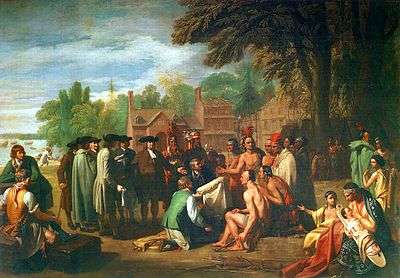Indian removals in Ohio
Indian Removals In Ohio were a process in the late 18th century extending into the 19th century, of the United States usurping Indian land in Ohio Country (later the state of Ohio) by conquest, or purchasing such land by treaty, and excluding Indians from it so as to facilitate settlement by European colonists.
The process began after the French and Indian War when Britain obtained sovereignty of lands west of the Appalachians from the French, and a trickle of frontiersmen from Britain's colonies in the New World began to migrate west. The French policy of trading and cooperation for mutual benefit was replaced with one of conflict and conquest as squatters claimed and settled on Indian lands. A series of boundary lines between Indian lands and Whiteman's lands were established by Treaty to reduce conflict, pushing the Indians northwestward. This resulted in the Northwest Indian War in Ohio Country, and the Cherokee-American wars in the Southwest Territory following the diversion of the American Revolution. After United States victory in the Indian War in Ohio, Indian reservations were created in the wake of usurpations. Later, reservations were quickly dismantled and (mostly beyond Ohio), Indians were forcibly relocated to Indian Territory west of the Mississippi. The reservations and relocations were a policy of extirpation rather than preservation that became a genocide of aboriginal American peoples.
The process of obtaining sovereignty over Indian lands was complete in Ohio by 1818, but continued in Indiana and beyond through at least 1840.
Background
The Indians of Ohio
Before the American Revolution, Ohio Country was populated by tribes of Shawnee (southwest), Miami (far west), Wyandot (northeast), Senecas (far northeast), and others. Ottawas (north)
Boundary lines
The Royal Proclamation of 1763 reserved what was then Ohio Country and lands beyond west of the Appalachians for Indians, and settlement by colonists was forbidden.[1] The Treaty of Fort Stanwix (1768) defined the Ohio River as the boundary between Indian lands and whiteman's lands west of the Appalachians. The Treaty of Fort McIntosh in 1785 circumscribed an area of central northern and northwestern Ohio Country as Indian land, essentially creating the first Indian reservation west of the Appalachians. The boundaries of that treaty followed natural landmarks and colonial forts, and became a blueprint for later treaties. Neither Indians nor settlers observed the boundaries of the treaty, resulting in the Northwest Indian War. The Treaty of Fort Harmar in 1789 which essentially reiterated the terms of earlier treaties, was a last attempt to placate the parties. Major United States army campaigns to assert sovereignty over the frontier ensued, culminating in the Unites States victory at Battle of Fallen Timbers in 1794.
The beginning
The United States dictated terms of the peace following the War, circumscribing a boundary line around state territories of Connecticut Western Reserve and Virginia Military District, along with the Symmes and Ohio Company land purchases to include most of southern and eastern Ohio in an area reserved to settlers. The Treaty of Greenville 1795 superseded and nullified all older treaties that conflicted with the new one. The treaty acquired about 2/3 of the future state of Ohio, leaving only the northwestern portion of Ohio Country for the Indians. Northwestern Indian lands were subsequently reduced by the Treaty of Fort Industry 1805 which moved the eastern boundary of Indian lands west to coincide with the western boundary of the Firelands, part of the Connecticut Western Reserve in northeastern Ohio. The process continued with:
- Treaty of Detroit 1807
- Treaty of Brownstown 1808
- Treaty of Greenville (1814) (not a land cession treaty)
- Treaty of Fort Meigs 1817
Completion and continuance
In fall of 1818, six treaties were part of the Treaty of St. Mary's (1818), including Treaty with the Miami, that ceded the final piece of Ohio between the Greenville Treaty Line and St. Mary's River, completing the acquisition of Ohio for the Whiteman. At the same time, the process of acquisition of lands and removal of Indians continued in Indiana with the other 5 treaties, acquiring nearly 1/3 of the land of Indiana thereby.
Removals
Indian treaties through 1818 in Ohio didn't require removal from the state, but Indians voluntarily relocated to Ohio reservations defined in the treaties. Treaties after 1818 involved purchase or cession of reservations, and Indians were removed to out of state Indian Territory.
The last Indians in Ohio were removed in 1843 via Treaty with the Wyandots (1842) by which the reservation at Upper Sandusky was ceded to the United States, and the Wyandots relocated to Oklahoma in 1843.
As of the 20th Century, there are no Indian reservations in Ohio, and no federally recognized Indian tribes in Ohio.
See also
- Indian Removal Act
- Twelve Mile Square Reservation (not an Indian reservation)
- Upper Sandusky Reservation (Wyandot)
- Moravian Indian Grants (Gnadenhutten, Schoenbrun, and Salem)
- Treaty of Lewistown (1829)
References
- President Washington's Indian War: The Struggle for the Old Northwest, Wiley Sword, University of Oklahoma Press, 1993 ISBN 978-0806124889
- "Royal Proclamation, 1763". IndigenousFoundations. The University of British Columbia.
